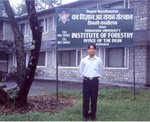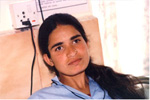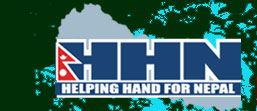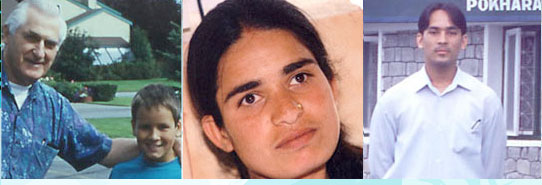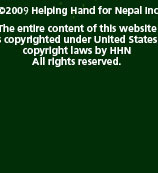KHIL KUMARI DAHAL
A heart patient for ten years, Khil's family had no money left
for her continuing medical needs. Facing either a double valve
replacement surgery or death within two months, Khil's family
put a notice in the Kathmandu newspaper pleading for help. HHN
secured a heart valve donation from Medtronics and raised money
for the surgery that saved Khil's life. She is now able to
marry and lead a normal life. Working with Gangalal National
Heart Center, Khil's life-saving surgery followed by successful
surgeries for six others led to the founding of HHN's Nepal
Medical Emergency Fund, which provides life-saving surgeries
for indigent Nepalis with no other hope. Professional fund
management is being donated.
SOM BAHADUR BOHORA SCHOLARSHIP
HHN became aware of a letter of appeal Som wrote requesting a
scholarship for his education at the Institute of Forestry in
Pokhara. A Dalit (Untouchable Caste) from Maoist-infested
Baglung with no resources of his own, Som had little chance of
any education without financial assistance. HHN researched the
situation, deciding to offer Som a yearly scholarship based on
his continued academic success. Som receives high marks
yearly, returns to his village during breaks to encourage other
Dalits to stay in school, and will graduate in 2007.
TAPLEJUNG DISTRICT HOSPITAL
A January newspaper article chronicled the woes of Taplejung
District Hospital, a Nepali hospital in the mountains with
broken windows in the Outpatient Department and no blankets
for the patients. After a fundraiser HHN purchased new wool
blankets in a local market and partnered with the Nepal Red
Cross for delivery to the hospital.
Other Success Stories:
BAUSCH AND LOMB INTRAOCULAR LENSES
HHN's Executive Director was invited by Nepal's Ministry of
Health to attend a World Health Organization conference in
Nepal called "Vision 2020: The Right to Sight". This ambitious
program challenges developing countries to identify and
eliminate their main source of avoidable blindness by the
year 2020.
The BP Koirala Center for Ophthalmic Studies requested IOLs
(intraocular lenses) for cataract surgery from HHN, pledging
to do these surgeries free-of-cost to indigent Nepalis in rural
and remote eye camps. Cataracts continue to be a large source
of avoidable blindness in Nepal. HHN secured a very generous
donation of thousands of IOLs for cataract surgery from Bausch
and Lomb.
HHN then successfully requested assistance from UPS in shipping
the IOL donation to Nepal. HHN is indebted to UPS for carrying
the lenses to Bangkok, Thailand, and to Royal Nepal Airlines for
carrying them the last leg of the trip to Kathmandu, Nepal.
BOOKS BY REQUEST FOR VILLAGE SCHOOLS
HHN began an online correspondence with a returned Peace Corps
Volunteer (PCV). She still had PCV friends in Nepal and through
her HHN received requests for specific books for various Nepali
village schools throughout the country. HHN successfully conducted
a book drive to meet these needs, sending 2,000 pounds of books to
these various Peace Corps Volunteers.
This began a yearly HHN book drive for specific books requested for
Nepali village schools. The main members of the book drive are the
Bartlett Book Brigade, retired teachers from Bartlett High School
in Anchorage, Alaska. Books went to the Peace Corps/Nepal for
distribution and use by PCVs and their Nepali counterparts. Books
now are distributed by Rato Bangala School through their
teacher-training program.
ELSEVIER SCIENCE MEDICAL JOURNALS
The BP Koirala Center for Ophthalmic Studies in Kathmandu is part of
Tribhuvan University. The Center requested HHN's assistance in
obtaining professional ophthalmic journals for their library, which
at that time received none on a regular basis. After learning from
HHN about the BPK Center's library for staff and students, Elsevier
Science graciously donated subscriptions to Ophthalmology and
American Journal of Ophthalmology.
RECYCLING MEDICAL TEXTS AND JOURNALS
After attending an informational presentation by HHN, the Medical
Librarian at the Alaska Native Medical Center, herself a returned
Peace Corps Volunteer, began saving medical texts and journals for
the teaching hospitals in Nepal. This kind soul even boxes the
books for shipment in M-bags. HHN ships the books and facilitates
their placement in Nepal.
ROTARY MATCHING GRANTS
Rotary District 5010, Anchorage Rotary Clubs, and the Rotary Club of
Kantipur in Nepal have been phenomenal in working with HHN to
alleviate avoidable blindness. The first Rotary Matching Grant
provided portable ophthalmic surgical equipment for use in rural and
remote eye camps. We worked in conjunction with Spectrum
Ophthalmics and Lombart-Midwest to provide quality surgical
equipment. DHL assisted with shipment. Partnering with the BP
Koirala Center for Ophthalmic Studies, these same Rotary Clubs
also made possible eye screening for thousands of school children,
including eye glasses and surgery as needed.
SURGICAL ITEMS AND MEDICAL
EQUIPMENT RECYCLING
As a result of HHN's presentation to the Director of Alaska Regional
Hospital, the medical facility donated and recycled non-utilized
surgical items to teaching hospitals in Nepal through HHN.
A U.S.-TRAINED OPTOMETRIST TO
TEACH A NEW PROFESSION
The BP Koirala Center for Ophthalmic Studies recognized the need for a
mid-level oph-thalmic-care professional in Nepal. With no initial
instructors, materials, or curriculum, their visionary Executive Director
started a School of Optometry--a new profession in Nepal. An appeal
was made to HHN for optometry instructors.
Correspondence with the World Council of Optometry provided a
series of excellent, but temporary, instructors from the U.S.
and Canada, while HHN lobbied the Peace Corps in Washington, DC,
and Nepal to create a new Peace Corps Volunteer (PCV) position
at the BPK Center. Eventually, this was granted and the search
was on to find an optometrist for this position.
HHN actively wrote Optometry Schools and professional journals
in the U.S. telling of this new PCV position, successfully
locating an interested new graduate. This wonderful young
lady taught at the Center and created curriculum and materials
for the Center staff to use after she left.
